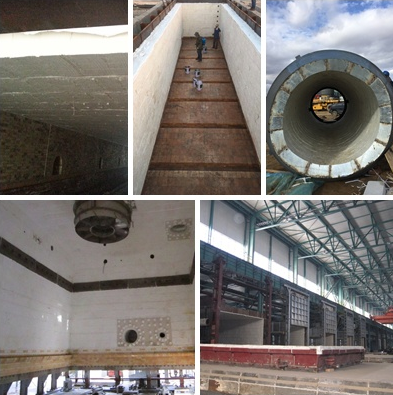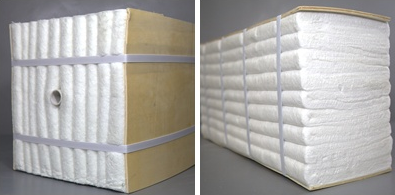Ceramic fiber module is a new refractory lining product introduced to simplify and speed up the construction of kiln and improve the integrity of lining. The ceramic fiber module is white in color and regular in size. It can be directly fixed on the steel anchoring nail of the furnace shell of the industrial kiln. It has good fire resistance and heat insulation effect, improves the integrity of fire resistance and heat insulation of the kiln, and promotes the progress of the kiln masonry technology.
—、Ceramic fiber module product features:
Excellent chemical stability; Excellent thermal stability; Excellent elasticity, ceramic fiber module is in the prepressure state, after the lining masonry is completed, the expansion of ceramic fiber module makes the lining without gap, and can compensate the fiber lining shrinkage, in order to improve the thermal insulation performance of fiber lining, the overall performance is good; Excellent thermal stability and thermal shock resistance; The ceramic fiber module is installed quickly, and the anchoring parts are set on the cold side of the wall lining, which can reduce the material requirements of the anchoring parts.
二、Typical application of ceramic fiber module:
Furnace lining insulation of kiln in petrochemical industry; Furnace lining insulation of metallurgical kiln; Ceramic, glass and other building materials industry kiln lining insulation; Heat treatment industry heat treatment furnace lining insulation; Other industrial kiln linings. With the advance of the national energy saving and emission reduction plan, the transformation of brick kiln is imminent. Ceramic fiber module is highly praised for its excellent thermal insulation performance in the ceiling of brick kiln.
三、Ceramic fiber modules can be divided into the following types according to different molding methods:
Module, including folding block, slice block, pie block, vacuum forming block. Due to the different preparation methods and texture of polycrystalline mullite fiber, the fiber length is short and the softness is poor. Unable to be made into large modules, resulting in polycrystalline fibers can not be used in large scale. At present, polycrystalline fiber is mostly used in castable or firebrick furnace wall, the inner surface of the top of the furnace, the use of polycrystalline fiber paste can effectively reduce the temperature of the furnace wall and reduce the heat storage loss of the furnace wall.
At present, most of the modules produced by domestic ceramic fiber manufacturers are ceramic fiber folding blocks and ceramic fiber modules. The structure uses double-sided needled blanket for folding, uses mechanical equipment to prepress the module when forming, and uses packing belt to bind and shrink, and removes the elastic extrusion of packing belt when installing to make the heat insulation sealing better. The ceramic fiber module is an upgraded folding block embedded with high temperature resistant metal anchors, which is smaller in size. Ceramic fiber modules and ceramic fiber folding blocks have their own advantages, and reasonable products or combinations are used according to the requirements of fire resistance and heat insulation applications. The slicing block is improved on this basis. Its production method is the same as that of the folding block, except that the folding part of the fiber blanket is cut off after forming to make the surface of the module even. The cost of slice block is slightly higher, and only some manufacturers produce it at present. Pelo block is a new type of module. The molding method is different from the above two types of modules. The fiber of the module after forming is not directional. The density of furnace top fiber module should be 230kg/m3, and the density of side wall fiber module should be 220kg/m3.
Post time: Mar-27-2023






